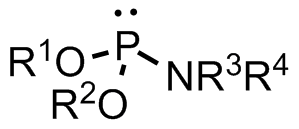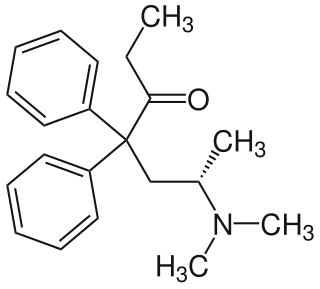| Look up asymmetric in Wiktionary, the free dictionary. |
Asymmetric may refer to:
Contents
- Asymmetry in geometry, chemistry, and physics
| Look up asymmetric in Wiktionary, the free dictionary. |
Asymmetric may refer to:

Asymmetric digital subscriber line (ADSL) is a type of digital subscriber line (DSL) technology, a data communications technology that enables faster data transmission over copper telephone lines than a conventional voiceband modem can provide. ADSL differs from the less common symmetric digital subscriber line (SDSL). In ADSL, bandwidth and bit rate are said to be asymmetric, meaning greater toward the customer premises (downstream) than the reverse (upstream). Providers usually market ADSL as a service for consumers for Internet access for primarily downloading content from the Internet, but not serving content accessed by others.

In an asymmetric multiprocessing system (AMP), not all CPUs are treated equally; for example, a system might allow only one CPU to execute operating system code or might allow only one CPU to perform I/O operations. Other AMP systems would allow any CPU to execute operating system code and perform I/O operations, so that they were symmetric with regard to processor roles, but attached some or all peripherals to particular CPUs, so that they were asymmetric with respect to the peripheral attachment. Asymmetric multiprocessing was the only method for handling multiple CPUs before symmetric multiprocessing (SMP) was available. It has also been used to provide less expensive options on systems where SMP was available. Additionally, AMP is used in applications that are dedicated, such as embedded systems, when individual processors can be dedicated to specific tasks at design time.
In mathematics, an asymmetric relation is a binary relation on a set X where:
Asymmetric warfare is war between belligerents whose relative military power differs significantly, or whose strategy or tactics differ significantly. This is typically a war between a standing, professional army and an insurgency or resistance movement militias who often have status of unlawful combatants.
Asymmetric Publications is a video game developer and publisher. It made the web-based role-playing game Kingdom of Loathing.
| This disambiguation page lists articles associated with the title Asymmetric. If an internal link led you here, you may wish to change the link to point directly to the intended article. |
Hardcore, hard core or hard-core may refer to:
Key may refer to:

Public-key cryptography, or asymmetric cryptography, is a cryptographic system that uses pairs of keys: public keys which may be disseminated widely, and private keys which are known only to the owner. The generation of such keys depends on cryptographic algorithms based on mathematical problems to produce one-way functions. Effective security only requires keeping the private key private; the public key can be openly distributed without compromising security.
Symmetric-key algorithms are algorithms for cryptography that use the same cryptographic keys for both encryption of plaintext and decryption of ciphertext. The keys may be identical or there may be a simple transformation to go between the two keys. The keys, in practice, represent a shared secret between two or more parties that can be used to maintain a private information link. This requirement that both parties have access to the secret key is one of the main drawbacks of symmetric key encryption, in comparison to public-key encryption.

Asymmetry is the absence of, or a violation of, symmetry. Symmetry is an important property of both physical and abstract systems and it may be displayed in precise terms or in more aesthetic terms. The absence of or violation of symmetry that are either expected or desired can have important consequences for a system.
Depth(s) may refer to:
Shift may refer to:
Ultra is the codename for cryptographic intelligence obtained from German signal traffic in World War II.
A revolver is a type of firearm.

Lisofylline (LSF) is a synthetic small molecule with novel anti-inflammatory properties. LSF can effectively prevent type 1 diabetes in preclinical models and improves the function and viability of isolated or transplanted pancreatic islets. It is a metabolite of pentoxifylline.
Beast or Beasts usually refer to large vertebrates, or more specifically mammals. It may also mean a scary, and vicious animal or character. It may also refer to:
Serpent or The Serpent may refer to:

A phosphoramidite (RO)2PNR2 is a monoamide of a phosphite diester. The key feature of phosphoramidites is their markedly high reactivity towards nucleophiles catalyzed by weak acids e.c., triethylammonium chloride or 1H-tetrazole. In these reactions, the incoming nucleophile replaces the NR2 moiety.

DuPhos is a class of organophosphorus compound that are used ligands for asymmetric synthesis. The name DuPhos is derived from (1) the chemical company that sponsored the research leading to this ligand's invention, DuPont and (2) the compound is a diphosphine ligand type. Specifically it is classified as a C2-symmetric ligand, consisting of two phospholanes rings affixed to a benzene ring.
Disclosure may refer to:
lsy-6 microRNA belongs to the class of miRNAs; these function to regulate the expression levels of other genes by several mechanisms. lsy-6 is a short non-coding RNA molecule and the first miRNA identified as having a role in nervous system development. It regulates left-right neuronal asymmetry in the nematode worm Caenorhabditis elegans.

Camphorsultam, also known as bornanesultam, is a crystalline solid primarily used as a chiral auxiliary in the synthesis of other chemicals with a specific desired stereoselectivity. Camphorsultam is commercially available in both enantiomers of its exo forms: (1R)-(+)-2,10-camphorsultam and (1S)-(−)-2,10-camphorsultam.

Dextromethadone is the (S)-enantiomer of methadone. Dextromethadone acts as a N-methyl-D-aspartate NMDA receptor antagonist.

Asymmetric addition of alkenylmetals to aldehydes is a chemical reaction in enantioselective synthesis that reacts an alkenylmetal with an aldehyde to give an allyl alcohol. The stereoselectivity in the reaction is typically controlled by the asymmetric ligands used providing a strategy to introduce controlled asymmetry into the molecule. Controlled molecular asymmetry is crucial for controlling the bioactivity of the synthesized molecules and demanded by drug authorities in drug synthesis. In this case the ligands chelate to the transition metal to create a chiral environment which enables the selective formation of a particular enantiomer. Various transition metals such as Zinc, Nickel, Chromium, and Rhodium have been used in this reaction.